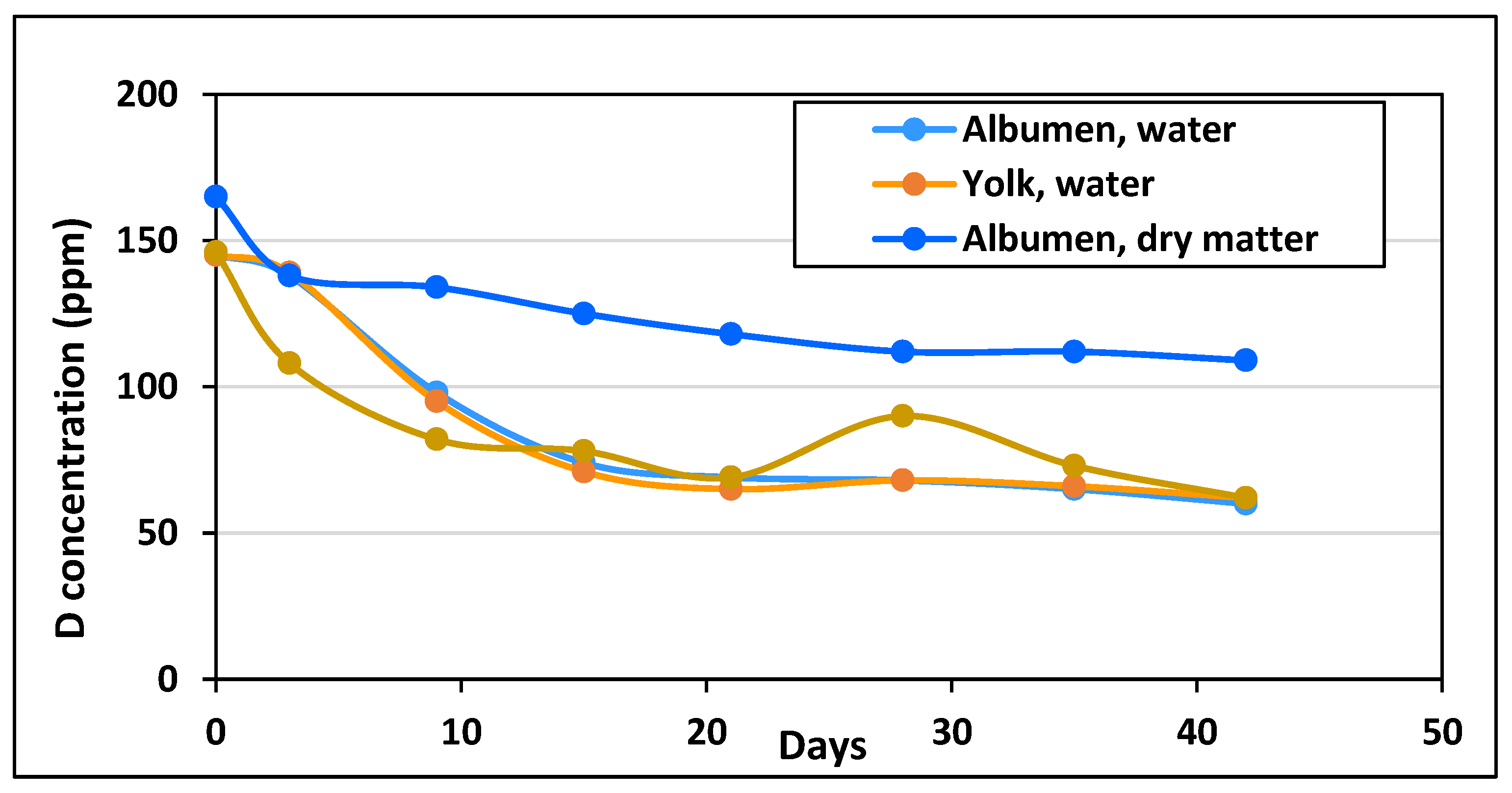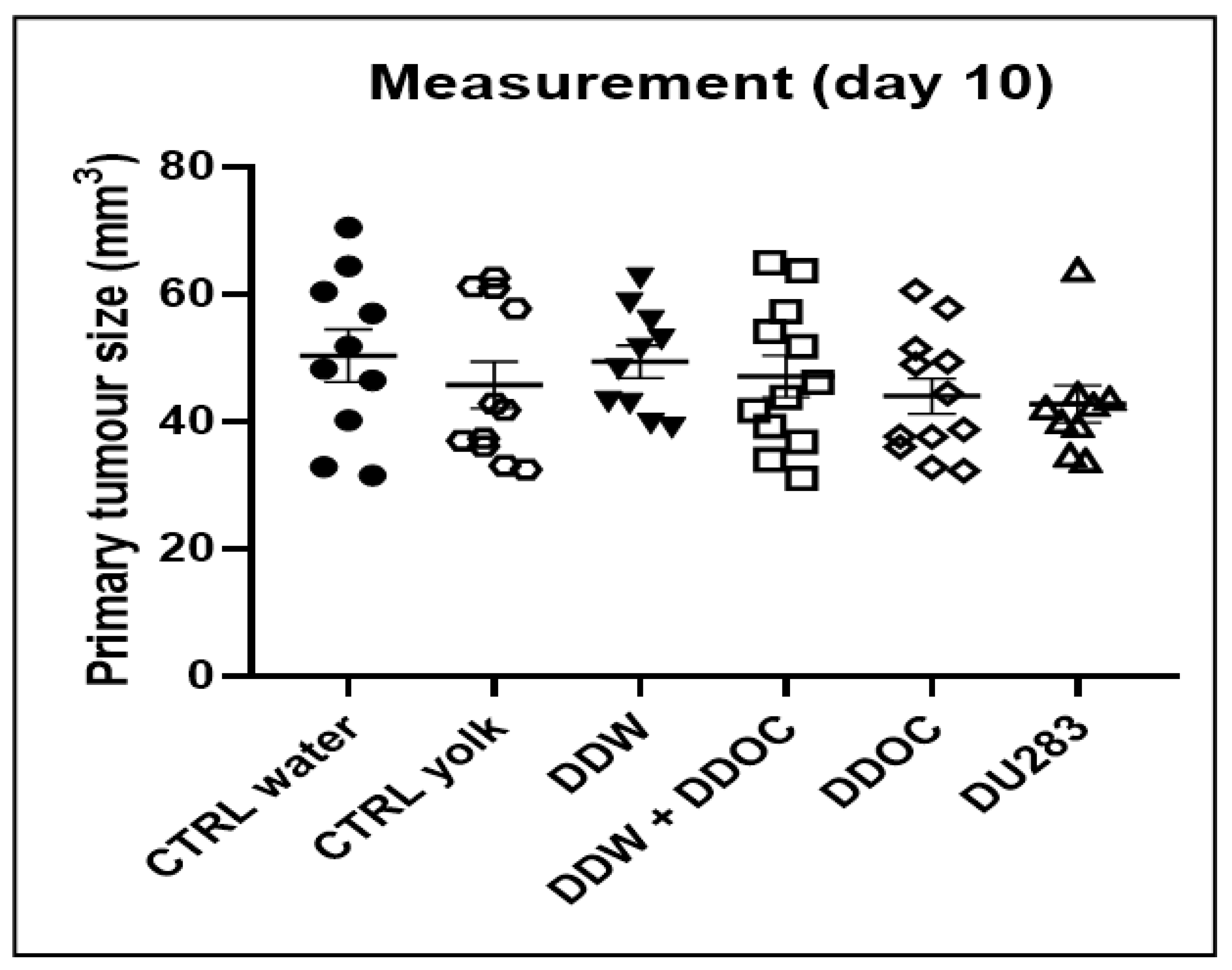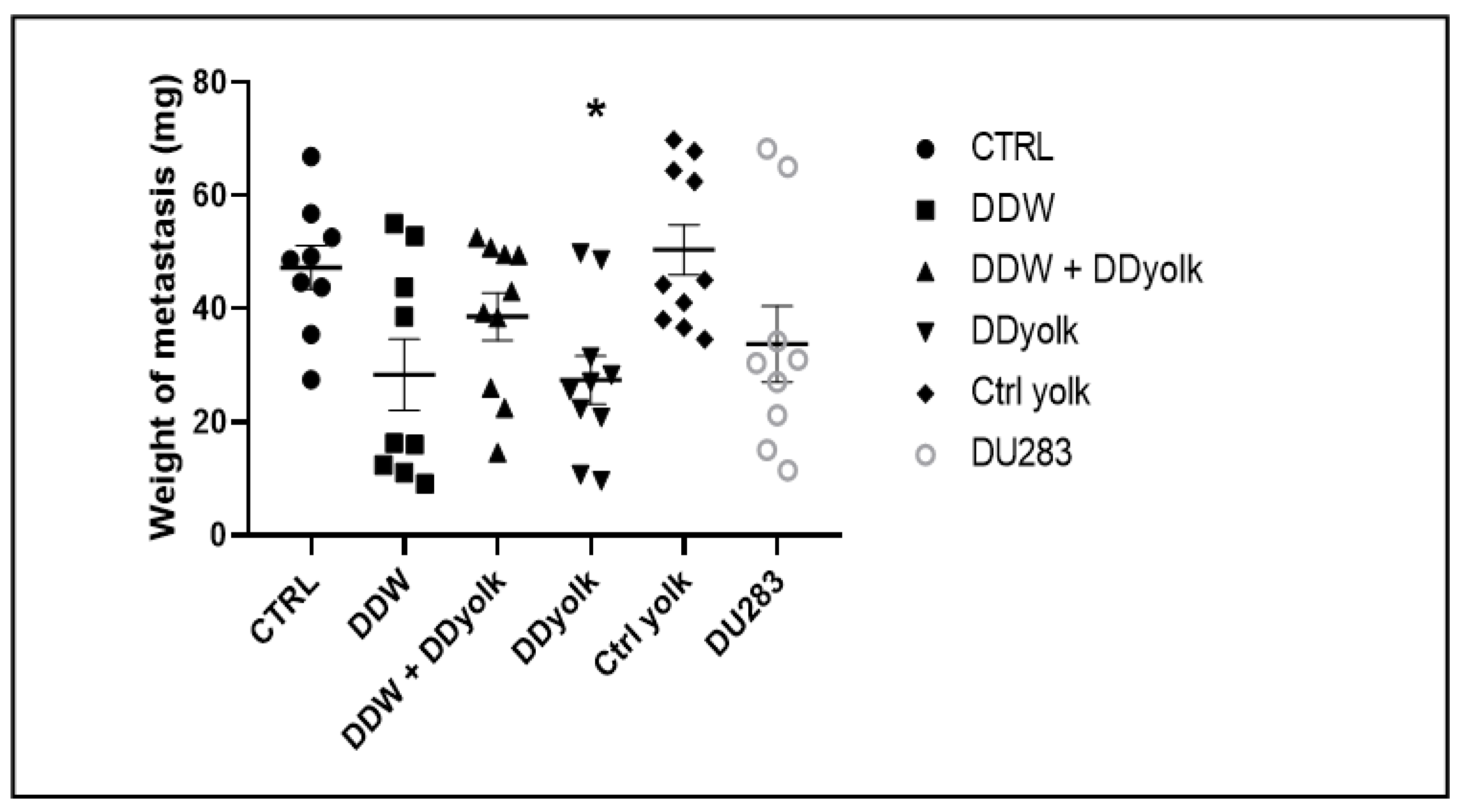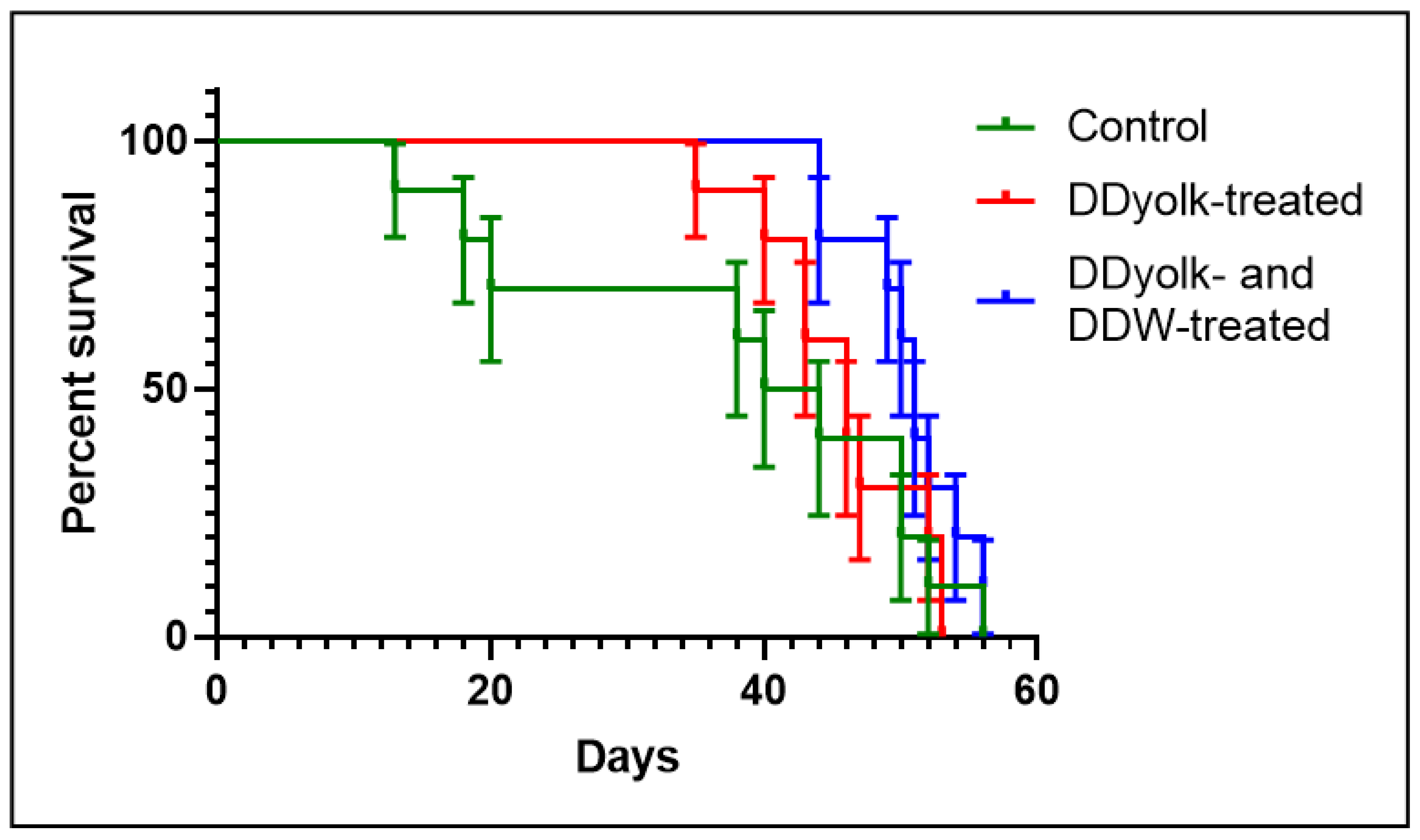Deuterium Content of the Organic Compounds in Food Has an Impact on Tumor Growth in Mice
Abstract
1. Introduction
2. Materials and Methods
2.1. Production of Deuterium-Depleted Nutrients, Measurements of D Concentration
2.2. Preparations Made for per os Treatment of the Mice
2.3. Cell Lines
2.4. Description of the In Vivo Studies
2.5. Ethical Considerations
3. Results
3.1. Production of Deuterium-Depleted Food
3.2. Tumor Growth in Mice Inoculated with 4T1 Breast Carcinoma Cells
3.3. Tumor Size and Survival in Mice Inoculated with Human MCF-7 Breast Cancer Cell Line
4. Discussion
Author Contributions
Funding
Institutional Review Board Statement
Informed Consent Statement
Data Availability Statement
Conflicts of Interest
Abbreviations
| D | deuterium |
| DDW | deuterium-depleted water |
| DDyolk | deuterium-depleted yolk |
| SMOW | Standard Mean Ocean Water |
References
- Urey, H.C. Deuterium. J. Chem. Educ. 1962, 39, 583. [Google Scholar] [CrossRef]
- Rundel, P.W.; Ehleringer, J.R.; Nagy, K.A. Stable Isotopes in Ecological Research; Springer: New York, NY, USA, 1988. [Google Scholar]
- Katz, J.J.; Crespi, H.L. Isotope Effects in Biologycal Systems. In Isotope Effects in Chemical Reactions; Collins, C.J., Bowman, N.S., Eds.; Van Nostrand Rein-hold: New York, NY, USA, 1971; pp. 286–363. [Google Scholar]
- Somlyai, G.; Jancsó, G.; Jákli, G.; Vass, K.; Barna, B.; Lakics, V.; Gaál, T. Naturally occurring deuterium is essential for the normal growth rate of cells. FEBS Lett. 1993, 317, 1–4. [Google Scholar] [CrossRef]
- Strekalova, T.; Evans, M.; Chernopiatko, A.; Couch, Y.; Costa-Nunes, J.; Cespuglio, R.; Chesson, L.; Vignisse, J.; Steinbusch, H.W.; Anthony, D.C.; et al. Deuterium content of water increases depression susceptibility: The potential role of a serotonin-related mechanism. Behav. Brain Res. 2015, 277, 37–244. [Google Scholar] [CrossRef] [PubMed]
- Mladin, C.; Ciobica, A.; Lefter, R.; Popescu, A.; Bild, W. Deuterium Depleted Water has stimulating effects on long-term memory in rats. Neurosci. Lett. 2014, 583, 154–158. [Google Scholar] [CrossRef]
- Ávila, D.S.; Somlyai, G.; Somlyai, I.; Aschner, M. Anti-aging effects of deuterium depletion on Mn-induced toxicity in a C. elegans model. Toxicol. Lett. 2012, 211, 319–324. [Google Scholar] [CrossRef]
- Molnár, M.; Horváth, K.; Dankó, T.; Somlyai, I.; Kovács, B.Z.; Somlyai, G. Deuterium-depleted water stimulates GLUT4 translocation in the presence of insulin, which leads to decreased blood glucose concentration. Mol. Cell. Biochem. 2021, 476, 4507–4516. [Google Scholar] [CrossRef]
- Kovács, B.Z.; Puskás, L.G.; Nagy, L.I.; Papp, A.; Gyöngyi, Z.; Fórizs, I.; Czuppon Gy Somlyai, I.; Somlyai, G. Blocking the Increase of Intracellular Deuterium Concentration Prevents the Expression of Cancer-Related Genes, Tumor Development, and Tumor Recurrence in Cancer Patients. Cancer Control 2022, 29, 1–11. [Google Scholar] [CrossRef] [PubMed]
- Gyöngyi, Z.; Somlyai, G. Deuterium depletion can decrease the expression of c-myc, Ha-ras and p53 gene in carcinogen-treated mice. Vivo 2000, 14, 437–440. [Google Scholar]
- Krempels, K.; Somlyai, I.; Somlyai, G. A retrospective evaluation of the effects of deuterium depleted water consumption on four patients with brain metastases from lung cancer. Integr. Cancer Ther. 2008, 7, 172–181. [Google Scholar] [CrossRef]
- Cong, F.S.; Zhang, Y.R.; Sheng, H.C.; Ao, Z.H.; Zhang, S.Y. Deuterium-depleted water inhibits human lung carcinoma cell growth by apoptosis. Exp. Ther. Med. 2010, 1, 277–283. [Google Scholar] [CrossRef] [PubMed]
- Kovács, A.; Guller, I.; Krempels, K.; Somlyai, I.; Jánosi, I.; Gyöngyi, Z.; Szabó, I.; Ember, I.; Somlyai, G. Deuterium Depletion May Delay the Progression of Prostate Cancer. J. Cancer Ther. 2011, 2, 548–556. [Google Scholar] [CrossRef]
- Somlyai, G.; Kovács BZs Somlyai, I.; Papp, A.; Nagy, L.I.; Puskás, L.G. Deuterium depletion inhibits lung cancer cell growth and migration in vitro and results in severalfold increase of median survival time of non-small cell lung cancer patients receiving conventional therapy. J. Cancer Res. Ther. 2021, 9, 12–19. [Google Scholar] [CrossRef]
- Ziegler, H.; Osmond, C.B.; Stichler, W.; Trimborn, P. Hydrogen isotope discrimination in higher plants: Correlations with photosynthetic pathway and environment. Planta 1976, 128, 85–92. [Google Scholar] [CrossRef]
- Sternberg, L.; Deniro, J.M.; Johnson, B.H. Isotope Ratios of Cellulose from Plants Having Different Photosynthetic Pathways. Plant Physiol. 1984, 74, 557–561. [Google Scholar] [CrossRef] [PubMed]
- Richard, J.R.; Robins, J.; Isabelle, B.; Jia-Rong, D.; S’ebastien, G.G.; S’ebastien, P.P.; Ben-Li, Z. Measurement of 2H distribution in natural products by quantitative 2H NMR: An approach to understanding metabolism and enzyme mechanism? Phytochem. Rev. 2003, 2, 87–102. [Google Scholar] [CrossRef]
- Robins, R.J.; Remaud, G.S.; Billault, I. Natural mechanisms by which deuterium depletion occurs in specific positions in metabolites. Eur. Chem. Bull. 2012, 1, 39–40. [Google Scholar]
- Seyfried, T.N.; Flores, R.E.; Poff, A.M.; D’Agostino, D.P. Cancer as a metabolic disease: Implications for novel therapeutics. Carcinogenesis 2014, 35, 515–527. [Google Scholar] [CrossRef] [PubMed]
- Somlyai, G. Deuterium Depletion Results in Several-fold Increases in the Median Survival Time of Cancer Patients durin Oncotherapy. In Proceedings of the 3rd International Congress on Deuterium Depletion, Budapest, Hungary, 7–8 May 2015. [Google Scholar]
- Hobson, K.A.; Atwell, L.; Wassernaar, L.I. Influence of drinking water and diet on the stable-hydrogen isotope ratios of animal tissues. Proc. Natl. Acad. Sci. USA 1999, 96, 8003–8006. [Google Scholar] [CrossRef]
- Prosser, S.J.; Scrimgeour, C.M. High-precision determination of 2H/1H in H2 and H2O by continuous-flow isotope ratio mass spectrometry. Anal. Chem. 1995, 67, 1992–1997. [Google Scholar] [CrossRef]
- Scrimgeour, C.M.; Rollo, M.M.; Mudambo, S.M.; Handley, L.L.; Prosser, S.J. A simplified method for deuterium/hydrogen isotope ratio measurements on water samples of biological origin. Biol. Mass Spectrom. 1993, 22, 383–387. [Google Scholar] [CrossRef]
- Pulaski, B.A.; Ostrad-Rosenberg, S. Mouse T1 Breast Tumor Model. Curr. Protoc. Immunol. 2001. [Google Scholar] [CrossRef]
- Szebeni, G.J.; Balog, J.A.; Demjén, A.; Alföldi, R.; Végi, L.V.; Fehér, L.Z.; Mán, I.; Kotogány, E.; Gubán, B.; Batár, P.; et al. Imidazo[1,2-b]pyrazole-7-carboxamides Induce Apoptosis in Human Leukemia Cells at Nanomolar Concentrations. Molecules 2018, 23, 2845. [Google Scholar] [CrossRef] [PubMed]
- Ying, X.; Tinghong, Y.; Mengyao, W.; Yong, X.; Ningyu, W.; Xuejiao, S.; Fengtian, W.; Li, L.; Yongxia, Z.; Fangfang, Y.; et al. A Novel Cinnamide YLT26 Induces Breast Cancer Cells Apoptosis via ROS -Mitochondrial Apoptotic Pathway in Vitro and Inhibits Lung Metastasis in Vivo. Cell. Physiol. Biochem. 2014, 34, 1863–1876. [Google Scholar] [CrossRef]
- Percie du Sert, N.; Hurst, V.; Ahluwalia, A.; Alam, S.; Avey, M.T.; Baker, M.; Browne, W.J.; Clark, A.; Cuthill, I.C.; Dirnagl, U.; et al. The ARRIVE guidelines 2.0: Updated guidelines for reporting animal research. Br. J. Pharmacol. 2020, 177, 3617–3624. [Google Scholar] [CrossRef]
- Guide for the Care and Use of Laboratory Animals, 8th ed.; The National Academies Press: Washington, DC, USA, 2011; Available online: https://journals.sagepub.com/doi/10.1258/la.2012.150312 (accessed on 2 December 2022).
- Zhou, W.; Mukherjee, P.; Kiebish, M.A.; Markis, W.T.; Mantis, J.G.; Seyfried, T.N. The calorically restricted ketogenic diet, an effective alternative therapy for malignant brain cancer. Nutr. Metab. 2007, 4, 5. [Google Scholar] [CrossRef]
- Seyfried, T.N.; Flores, R.; Poff, A.M.; D’Agostino, D.P.; Murkherjee, P. Metabolic Therapy: A new paradigm for managing malignant brain cancer. Cancer Lett. 2014, 356, 289–300. [Google Scholar] [CrossRef]
- Khodadadi, S.; Sobhani, N.; Mirshekar, S.; Ghiasvand, R.; Pourmasoumi, M.; Miraghajani, M.; Dehsoukhteh, S.S. Tumor Cells Growth and Survival Time with the Ketogenic Diet in Animal Models: A Systematic Review. Int. J. Prev. Med. 2017, 8, 35. [Google Scholar] [CrossRef]
- Somlyai, G. Deuterium Depletion—A New Way in Curing Cancer and Preserving Health; Publish Drive: Redwood City, CA, USA, 2022; pp. 36–37. [Google Scholar]
- Somlyai, G.; Somlyai, I.; Fórizs, I.; Czuppon Gy Papp, A.; Molnár, M. Effect of Systemic Subnormal Deuterium Level on Metabolic Syndrome Related and other Blood Parameters in Humans: A Preliminary Study. Molecules 2020, 25, 1376. [Google Scholar] [CrossRef]
- Zhang, Z.; Meng, Z.; Beusch, C.; Gharibi, H.; Cheng, Q.; Stefano, L.; Wang, J.; Saei, A.; Vegvari, A.; Gaetani, M.; et al. Ultralight ultrafast enzymes. Chem. Proteom. 2021. online 2021-12-15. [Google Scholar] [CrossRef]





| Group | Type of Treatment | ||
|---|---|---|---|
| Drinking Fluid | Food | Drug | |
| Untreated control | Normal water | VRF1 | |
| Treated | DDW | VRF1 | |
| Treated | DDW | VRF1 + deuterium-depleted yolk | |
| Treated | Normal water | VRF1 + deuterium-depleted yolk | |
| Untreated control | Normal water | VRF1 + normal yolk | |
| Positive control | Normal water | VRF1 | DU283 |
| Groups | Drinking Fluid | Food |
|---|---|---|
| Untreated control | Normal water | VRF1 supplemented with normal yolk |
| Treated | DDW | VRF1 supplemented with normal yolk |
| Treated | DDW | VRF1 supplemented with deuterium-depleted yolk |
| Treatment | Weight of the Metastasis (Milligrams; mean ± SEM, n = 10)) |
|---|---|
| Normal water (CTRL) | 45.20 ± 4.02 |
| DDW | 32.13 ± 6.81 |
| DDW + deuterium-depleted yolk (DDyolk) | 37.86 ± 5.47 |
| Normal water + DDyolk * | 32.19 ± 4.80 * |
| Normal water + normal yolk (Ctrl yolk) | 46.96 ± 5.30 |
| Normal water + DU283 | 33.78 ± 6.71 |
| Type of Foodstuff | D concentration of Dry Matter (ppm) |
|---|---|
| Wheat flour | 150 ± 1 |
| Table sugar | 146 ± 1 |
| Cottage cheese | 136 ± 1 |
| Olive oil | 130 ± 1 |
| Butter | 124 ± 1 |
| Pork fat | 118 ± 1 |
Disclaimer/Publisher’s Note: The statements, opinions and data contained in all publications are solely those of the individual author(s) and contributor(s) and not of MDPI and/or the editor(s). MDPI and/or the editor(s) disclaim responsibility for any injury to people or property resulting from any ideas, methods, instructions or products referred to in the content. |
© 2022 by the authors. Licensee MDPI, Basel, Switzerland. This article is an open access article distributed under the terms and conditions of the Creative Commons Attribution (CC BY) license (https://creativecommons.org/licenses/by/4.0/).
Share and Cite
Somlyai, G.; Nagy, L.I.; Puskás, L.G.; Papp, A.; Kovács, B.Z.; Fórizs, I.; Czuppon, G.; Somlyai, I. Deuterium Content of the Organic Compounds in Food Has an Impact on Tumor Growth in Mice. Curr. Issues Mol. Biol. 2023, 45, 66-77. https://doi.org/10.3390/cimb45010005
Somlyai G, Nagy LI, Puskás LG, Papp A, Kovács BZ, Fórizs I, Czuppon G, Somlyai I. Deuterium Content of the Organic Compounds in Food Has an Impact on Tumor Growth in Mice. Current Issues in Molecular Biology. 2023; 45(1):66-77. https://doi.org/10.3390/cimb45010005
Chicago/Turabian StyleSomlyai, Gábor, Lajos I. Nagy, László G. Puskás, András Papp, Beáta Z. Kovács, István Fórizs, György Czuppon, and Ildikó Somlyai. 2023. "Deuterium Content of the Organic Compounds in Food Has an Impact on Tumor Growth in Mice" Current Issues in Molecular Biology 45, no. 1: 66-77. https://doi.org/10.3390/cimb45010005
APA StyleSomlyai, G., Nagy, L. I., Puskás, L. G., Papp, A., Kovács, B. Z., Fórizs, I., Czuppon, G., & Somlyai, I. (2023). Deuterium Content of the Organic Compounds in Food Has an Impact on Tumor Growth in Mice. Current Issues in Molecular Biology, 45(1), 66-77. https://doi.org/10.3390/cimb45010005







